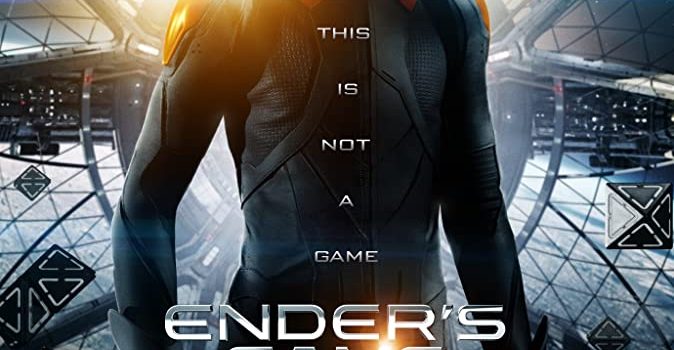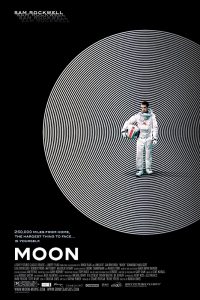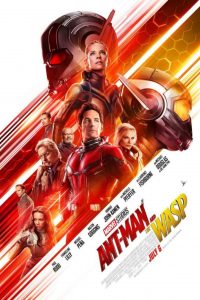Winners and Losers: A Review of Ender’s Game
 by Gary Westfahl
by Gary Westfahl
In several respects, Ender’s Game represents precisely the sort of film that I have been calling for in recent reviews, since it rejects the simplistic and unrealistic world view of melodrama, refuses to divide the universe into virtuous heroes and despicable villains, and explicitly endorses efforts to understand and reconcile with apparent enemies. The film’s pacifistic philosophy recalls the admirable sentiments of Gene Roddenberry’s original Star Trek (1966-1969), and its story resonates with the classic episode “Arena” (1967), in which William Shatner’s Captain Kirk, like Asa Butterfield’s Ender Wiggins, ultimately recoils against instructions to kill an alien foe whose only real sin is its monstrous appearance. Further, while making this point, Ender’s Game never fails to be entertaining, and there are no substantive complaints to make about its acting or production values.
Still, this is also a strangely unsatisfying movie; one leaves the theatre searching for reasons to dislike it. This has nothing to do, one must hasten to say, with the odious personal beliefs of Orson Scott Card, author of the novel that inspired the film (and also one of the film’s producers). Granted, Card has made some statements about homosexuality that were both remarkably vitriolic and remarkably stupid, but it’s hard to wish for a world with less polarization and more communication while simultaneously demanding a boycott of the works of every writer that you disagree with. (And, for that matter, the later writings of Robert A. Heinlein contain many detestable opinions, but I remember no calls for a boycott of Starship Troopers [1997]). The way that this film addressed the embryonic controversy related to Card’s attitudes is actually amusing; clearly, producer Card did not want to include any openly homosexual characters, but the filmmakers were sensitive to possible complaints that their film was excluding homosexuals – so they decided to exclude heterosexuals as well. In fact, it is hard to recall another recent film that is so relentlessly asexual: even when they are practicing their wrestling moves, one gets not the slightest hint that Ender and his female colleague Petra Arkanian (Hailee Steinfeld) are anything but best buddies, just as one never suspects that Colonel Graff (Harrison Ford) might be canoodling with his attractive subordinate, Major Gwen Anderson (Viola Davis).
No, the problems in this unlikable film are more fundamental, rooted in the history of its source material and perhaps indicative of a basic difference between written narratives and film narratives. The quickest way to describe what’s wrong with this film is to say that it conveys mixed messages: for much of its length, it endorses the notion that killing alien insects is good, but its conclusion indicates that killing alien insects is actually bad. There were similar tensions in the original Star Trek, as I suggested in an obscure essay with a title that summarized its argument: “Opposing War, Exploiting War: The Troubled Pacifism of Star Trek” (2000). In a nutshell, the series incongruously kept pointing out the evils of violence in episodes filled with gratuitous violence, such as “Arena,” one example mentioned in the essay. But what Ender’s Game does is much more troubling: after employing every trick in the film director’s handbook to persuade viewers to embrace one viewpoint, it turns around and condemns those viewers for being so thoughtlessly immoral as to embrace that viewpoint. If you enjoyed our movie, the filmmakers ultimately say, you were gullible, reprehensible dupes.
Consider, then, how the film masterfully made its audience despise the alien Formics. We are shown their fleet of spaceships attacking the Earth and repeatedly told about the many innocent people that they killed. We come to like the boy being trained to defeat them because he keeps getting picked on for no reason, arousing our sympathy, and because he keeps managing to triumph even though the cards are stacked against him; the boys who pester him are obvious creeps, while all the nice boys (and girl) happily gravitate toward him as their natural leader; and we are regularly reminded of what a wonderfully brilliant person he is. More powerfully, the chief advocate of wiping out the despicable aliens, and Ender’s most enthusiastic supporter, is played by Harrison Ford, a casting decision unambiguously announcing that he must be right. Ford has a history of playing heroes – from the teenage rescuer in American Graffiti (1973) to Han Solo, Indiana Jones, and Jack Ryan – so audiences naturally expect that, like Tom Hanks and Morgan Freeman, he will emerge as this film’s hero, who successfully mentors Ender to his grand triumph over the Formics. If director Gavin Hood had altered his casting to have Ben Kingsley play Graff (instead of the less pivotal role of Mazer Rackham), that actor would have been just as effective, but Hood would not be telling viewers so clearly that Graff should be admired. So it comes as an unpleasant shock when we are finally, and suddenly, informed that Graff is actually a complete jerk; it is effectively an attack on the viewer’s good judgment.
Ender’s Game is therefore similar to the original version of I Am Legend (2007) (review here), which also concluded unexpectedly with Will Smith discovering that the mindless, homicidal monsters he had been battling against for the entire film were actually intelligent, friendly, and terribly misunderstood. However, while this was in keeping with the ending of Richard Matheson’s original novel (1954), test audiences uniformly despised this dénouement, requiring director Francis Lawrence to film a new ending affirming that the film’s monsters were really monsters. And even though I was not particularly fond of the released film, I had to admit, in a posted comment on film adaptations of novels, that this decision was the correct one, as the replacement ending better matched the contents of the rest of the film. In like fashion, Ender’s Game might have been better advised to employ the ending of Card’s original story “Ender’s Game” (1977), in which the only bad thing that Graff and his colleagues are doing is exploiting children and depriving them of a normal childhood as part of their desperate effort to save humanity. But no questions are raised about the morality of slaughtering the Formics, who have repeatedly attacked Earth, and when Ender discovers that he has actually destroyed their planet, he is angry at Graff only because he has been used as a tool: “You needed a weapon, and you got it, and it was me.” But he expresses no guilt about being tricked into committing xenocide; that reaction, and the ultimately sympathetic portrayal of the Formics, were only added to the novel.
Matheson’s novel has been reasonably well regarded, if not accepted as a classic, while Card’s Ender’s Game (1985) was highly acclaimed, winning both the Nebula Award and Hugo Award, and it has been repeatedly republished. One would be hard-pressed to argue that their conclusions are flawed, yet they seem that way when the novels are adapted as films. This may be due to the fact that books, while they can arouse strong emotions, are not as viscerally involving as films, since one retains a certain sense of detachment from the printed page. Reading a final chapter in which a charming hero is revealed to be a murderer, one might be surprised and disappointed, but not disturbed. However, if a film makes us fall in love with Tom Hanks all over again and then tells us that he is actually a vicious serial killer, that is much more upsetting; films suck us into their worlds, and we want their stories to end in the properly satisfying manner. In the case of Ender’s Game, when Ender destroys the Formics’ planet, audiences want to feel thrilled and elated, as they felt when the Death Star was blown up at the end of the original Star Wars (1977). They don’t want to look into the soulful eyes of a dying Formic and regret the passing of a strange and noble species that just accidentally happened to almost wipe out the entire human race.
Another issue with the film’s ending also relates to the history of cinema, since Ender’s Game, more so than the novel, is so obviously in dialogue with a classic film genre, the World War II film, in which American boys from disparate backgrounds bond during basic training and go on to effectively fight together against the Germans and the Japanese. It has all of the standard elements: the outwardly gruff but secretly supportive drill sergeant Dap (Nonso Anozie), who concludes his work by saluting the successful recruit; the two rows of bunk beds where recruits, upon the sudden arrival of the sergeant, must stand at attention; the two young soldiers who are initially enemies but become friends – Ender and Bernard (Conor Carroll); the soldiers who convey messages by where they sit with their trays of food in a stark mess hall; the grueling practice sessions that gradually transform the raw recruits into skilled fighters; and so on. The only natural conclusion to all of this is to send the new soldiers into battle, have them achieve a glorious victory over the hated enemy, and show them congratulating each other – not to have them pause after its conclusion, look crestfallen, and mournfully ask, “What have we done?” It is possible to subvert the narrative of basic training in order to prepare viewers for a less uplifting ending, which is what a director more skillful than Gavin Hood, Stanley Kubrick, did in Full Metal Jacket (1987); there, basic training is presented as the sadistic process of transforming nice young men into killing machines and emotionally crushing anyone who can’t fulfill this role, and this appropriately precedes their participation in a conflict, the Vietnam War, which isn’t really worth fighting. But Hood numbly replicates all of the clichés of the basic training saga as if unaware that they are leading his cast toward a happy ending that they will not be allowed to achieve.
While Ender’s Game fails to argue with a conventional tradition that it mostly follows, it also fails to fully exploit its unconventional conclusion, which despite its incongruity might still be defended as courageous. Consider this: just as science fiction films of the 1950s frequently likened their evil aliens to evil Communists, science fiction films of the last decade have incessantly likened their evil aliens to our current enemies, evil terrorists; indeed, it would overly clutter this text to list all of the previous reviews where I noted some overt reference to 9/11 in a film about alien invaders. In the context of its times, then, Star Trek was a bit daring in first presenting its Klingons and Romulans as futuristic equivalents to America’s foes, the Russian and Chinese Communists, and then suggesting that maybe, just maybe, they weren’t all that implacably evil, and maybe, just maybe, we could get along with them. So, if a contemporary film is also going to recast seemingly sinister aliens as potential friends, it would be similarly daring to link them to present-day terrorists and suggest that maybe, just maybe, there is a solution to the problem of terrorism that doesn’t involve slaughtering all of the world’s terrorists and all of their sympathizers. In that spirit, if Hood had wished to provoke a controversy worth provoking (unlike the question of whether one should patronize the works of a virulently anti-gay author), he might have included in his flashbacks of the Formic invasion a scene in which their spacecraft destroy some iconic building in New York City. But nothing of the kind is observed; one can learn from what a film omits, as well as from what it includes, and the only clue Ender’s Game offers about its unusual ending is the fact that it is surely the first film about an alien invasion produced since 2001 that fails to reference the September 11 attacks. Its Formics are not allowed to resemble any of America’s actual enemies; its message, therefore, is simply a call for people everywhere to make an effort to get along with a nonexistent alien species. And no, that isn’t particularly courageous.
Perhaps Hood was focusing more of his efforts on providing his future world with innovative visuals, which indeed are often impressive. He addresses the special qualities of zero gravity in an early scene where Graff suspends himself horizontally while speaking to vertical recruits, and Ender displays his perspicacity by commenting on this consequence of weightlessness – you don’t have to orient yourself the same way as the others around you. Ender’s battles with other teams are staged in a well rendered zero-gravity chamber, a large transparent sphere with metallic obstacles where players maneuver in formations and try to strike opponents with paralyzing guns. Later, there is a magnificent scene where Ender stands above his assistants and gestures expansively like an orchestra conductor, though his movements are shown to be guiding Earth’s spaceships instead of musical instruments. And while the film’s brief scenes on Earth are generally uninspired, Hood does remember to provide Graff with a strikingly futuristic car. The film has several nice moments, then, but one still wishes that Hood had devoted more time to working on his script.
Overall, what Ender’s Game needed to do was to resolve the inconsistency between Card’s story and Card’s novel, an inconsistency that was not troubling in the novel but proved very troubling in this film. Hood might have resolved to adapt the original story and produce a traditional but rousing epic about virtuous humans defeating evil aliens, or he might have honored both the plot and spirit of the novel by producing a film that from the very beginning laid the groundwork for its ending with a less celebratory rendering of Ender’s preparations for battle and some effort to relate its story to contemporary concerns. Its most fascinating scene, which might be said to epitomize its problems, features Hood’s own credited appearance as a giant in the “mind game” that Ender periodically plays. As the game is designed, the giant offers the player a purported choice between a chalice filled with poison and one that will take him to a fairyland, but in fact whichever cup one chooses is invariably poisoned. Ender addresses the frustrating dilemma by refusing to choose; instead, his rodent-like avatar smashes into the giant’s eye, knocks him down, and runs over his prostrate body to adventures that the game designers did not anticipate. The scene suggests two things: Ender will be advancing his story in ways that one would not expect, and he is going to do so to the dismay and consternation of his blind director. Hood has been defeated by his own protagonist; he is literally the biggest loser in Ender’s game. Still, even if he could not quite get a good handle on his source material, he is certainly not the first director who has faltered in an effort to satisfactorily adapt a classic science fiction novel to the screen, and it might be deemed uncharitable to focus so heavily on his film’s flaws when it was so successful in some respects. But for better or worse, being uncharitable is often a film critic’s primary responsibility.









6945.1
Ender’s Game (2013) Written/directed by Gavin Hood, based on the novel by Orson Scott Card. Starring: Asa Butterfield as Ender Wiggins, Harrison Ford as Colonel Graff, Ben Kingsly as Mazer Rakham, Viola Davis as Major Gwen Anderson, Hailee Steinfeld as Petra Arkanian, Aramis Knight as Bean, and Abigail Breslin as Valentine Wiggin is:
The Best Science Fiction film of 2013.
One of the best films of 2013, overall.
The best and most faithful adaptation of an award-winning (Hugo, Nebula) Science Fiction novel ever made.
The most intense film I saw in 2013 that wasn’t based on actual events.
The most compelling fictional tale told at the movies in 2013.
Ender Wiggin is the second titular character Asa Butterfield has played in his young career, after 2011’s Hugo, directed by Martin Scorsese… It’s easy to see why so much confidence has been placed in his talents, as Butterfield NAILED both roles! His Ender Wiggin is a force of nature, and yet, still a kid! As Ender, Butterfield will break your heart, and make you cheer for the little guy who would not allow anyone/thing to beat him!
Harrison Ford’s Colonel Graff, commander of “Battle School”-which is actually a front for Earth’s defense force-is better than he has been in years! Ford obviously connected with this role, because his passion is readily apparent, and never lets up! Ford has kinda been coasting for a while, working, but coasting, never really immersing himself in a new role, until this year, brilliantly playing Branch Rickey in 42, and now, Colonel Graff, in Ender’s Game! Harrison Ford is back!
As Major Gwen Anderson, Viola Davis raises most of the moral questions related to asking children to fight the proverbial “War to End all Wars…”, but ultimately, the responsibility is Colonel Graff’s, who puts the fate of all humanity on the shoulders of Ender… The impossible choices made in EG will make you think, long after seeing the film… Were the choices made the right ones, even if they were the most expedient, the safest?
The supporting cast is uniformly excellent, from Abigale Breslin as Ender’s sister, Valentine, to Hailee Steinfeld as Ender’s Battle School sidekick, Petra… I was especially moved by the performance of Nonso Anozie, as Sergeant Dap-when Dap finally salutes Ender, I was moved to tears!
Based on director Gavin Hood’s filmography, especially Wolverine: Origins, I was concerned that Ender’s Game could be yet another SF debacle, along the lines of the remakes of the Day the Earth Stood Still, The Time Machine, and I Am Legend-but, not to worry! The film Ender’s Game most reminds me of is Paul Veerhoven’s Starship Troopers, with the critical difference that Veerhoven’s Starship Troopers bares little resemblance to Robert Heinlein’s Hugo Award winning novel, while Gavin Hood’s Ender’s Game is an extremely faithful adaptation of Orson Scott Card’s Hugo and Nebula Award-winning novel… Ender’s Game is the film that Starship Troopers should have been, way back in 1997…
EG is the best film Gavin Hood has written/directed-by far! The CGI is breathtaking and seamlessly woven with the live action shots… The weightless sequences are on par with those in Gravity, which were the best ever achieved! EG is a beautiful, imaginative, intense SF film, which poses thought-provoking questions! I was wired by the end of the film, elated, and exhausted! Ender’s Game is perhaps the most intense film I’ve seen since 2009’s The Hurt Locker, and the best “Hard” SF film since 2005’s Serenity, written/directed by Joss Whedon…
Even after all I’ve written, I can’t begin to express how moved I was by Ender’s Game-except to say that I forgot I was sitting in a theater, watching a movie… I “connected” with this film, as if I was there! Higher praise than that I can’t give!
Grade: A+
Ken
Nice article, except Ford did not play a hero in American Graffiti … quite the opposite, actually.
There are so many things wrong with this review. The Formics do not ‘repeatedly attack earth’ It clearly states in the movie that they came for water and possibly to start a colony. Out of fear the humans attacked the Formics and the Formics protected themselves. The reviewer states that the characters are asexual and yet Dap promises punishment to any recruit who enter the restroom/shower area of the opposite gender, not something necessary amongst asexual individuals. And all of the smiles and brief pauses exchanged between Ender and Petra are asexual. (spoilers) And of course Ender expresses guilt for being deceived. It is his tears at the end in that pivotal moment with the remaining Formic Queen where he promises to make things right and find a suitable place for the egg to start the Formic race over. He knows he can’t go back. He can’t change the past, but he can correct the future in a limited way and that is by going forward. And why must the Formics resemble any of America’s “enemies?” (You kill enough people in a certain country and they’re not going to like you.) The book was written in 1985. The movie does not “successfully” make the audience hate the Formics. They are not even seen as creatures until the mouse of Ender defeats the giant. No one knows anything about the Formics except the little they are told and this is quite plain from the scene when Ender is watching the Mazer Rackham footage. The movie only reveals as much as the characters themselves know about the Formics and their own attitudes. And the final scene–if it suggests anything–it is to expect more following. It doesn’t tell you what to expect. Lastly it is impossible to make a competent movie about the evils of violence without showing it. What do you expect, flowers, puppies and bubblegum? Ultimately this review has nothing to do with the movie and everything to do with the reviewer. Throughout you have been seeking something not like about the movie and you did, none of which was actually in the movie, all of which was in you.
By the way, since the first Thor was stupid, I’m skipping it and I’m taking my dad to see the best release of the last four weeks. I’m going to see Ender’s Game.